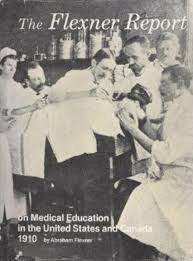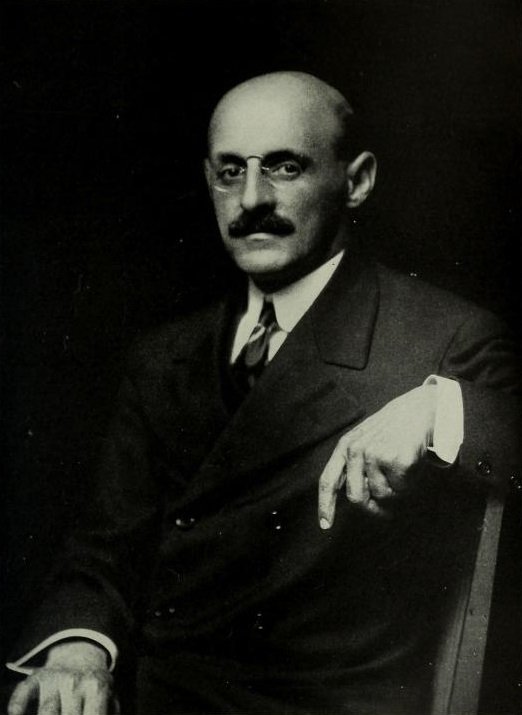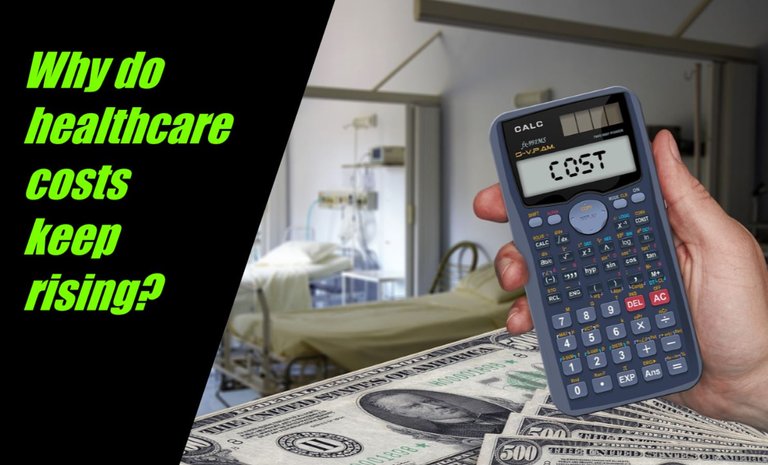The High Cost of Health Care: the Flexner Report (Part 1 - its progressive efficient-monopoly angle)
This is a series on the history of health care, exploring how and why health care costs in the US have risen beyond the levels a free market would normally bear. Other posts in this series:
Is health insurance sustainable?
Medical cartels an early response to natural medicine

Introduction
One of the first damaging government interventions into the United States' healthcare industry came en masse at the state level shortly after 1910. Under the guise of standardizing medical education, the states began implementing licensure standards that decimated the supply of competing schools, causing medical education to become ridiculously expensive and causing healthcare costs to rise over the coming decades.
These damaging regulations were the direct result of a study commissioned by the American Medical Association. The study was titled the “Flexner Report” and it recommended just this type of progressive (competition-reducing) reform. The report also contained further recommendations that can only be described as racist and sexist.
In fact, there are three damning aspects to this report that deserve our attention: 1) its progressive efficient-monopoly angle, 2) its discrimination angle, and 3) its German pharmaceutical angle. This post will address only the first.

Brief Overview

The Flexner Report was published by the Carnegie Foundation for the Advancement of Teaching (CFAT), a group contracted by the AMA's Council on Medical Education (CME) to survey the state of medical schools across the United States and Canada in 1909. The AMA then lobbied the states to implement the report's recommendations of reducing the number of medical schools and the number of medical school graduates, as well as to allow the AMA's own state offices to oversee the mergers of many schools.
State governments were happy to comply with the AMA's requests, largely because state medical boards were already manned by individuals hand-picked by the AMA, a lobbying association for doctors. In 1910, the AMA represented 70,000 members, doctors whose main complaint was a low income level. Clearly, existing doctors at the time would have benefitted from the resulting lower numbers of medical school graduates. Fewer new doctors would mean less competition and the ability to charge higher prices. And in fact, this is exactly the sort of situation an industry association like the AMA would push for when lobbying.

In-Depth Examination
The AMA's Council on Medical Education (CME) had been formed six years before the Flexner Report was published with the goal of completely restructuring medical education. It was this council that commissioned the Carnegie Foundation for the Advancement of Teaching (CFAT) to produce a report on the state of medical education in North America in hopes that such a report would aid in that restructuring.
CFAT's president at this time was a man named Henry Pritchett, who had recently left his former position as president of the Massachusetts Institute of Technology (MIT). According to an article in Academic Medicine (Kanter, Groce, Littleton, Gunderman, authors), “Pritchett... conceived of the study, foresaw many of its conclusions based on his preliminary research, selected Abraham Flexner to evaluate North America's medical schools, and, through his writing and advocacy after the report's release, played a major role in ensuring that many of the report's recommendations became reality.”
At its most legitimate, the Flexner Report called for consistent, scientific standards in medical education, as explained by Pritchett, who wrote its Introduction: “[I]n the face of the advancing standards of the best medical schools it was clear that the time had come when the relation of professional education in medicine to the general system of education should be clearly defined.” (p.viii) He went on, however, to summarize a very different set of goals on page xi of his Introduction: “[P]rogress for the future would seem to require a very much smaller number of medical schools... and the needs of the public would equally require that we have fewer physicians graduated each year...”
So why this focus on reducing the number of medical schools and doctors? The answer involves the progressive belief of the time that competition was destructive and should be eradicated in order for society to progress.
The Flexner Report was very much a product of the early progressive movement and both Flexner and Pritchett were typical progressives of their day. The actual tenets of early progressivism, however, might surprise you. Contrary to what most of us were taught in school, early progressives supported trusts, business mergers, and consolidations for the sake of efficiency. For a brief history on these ideas, below is a short video I made years ago:
To understand the context of the Flexner Report, it's important to know that progressives in the early 20th century were extremely critical of competition, including the type of competition necessary to prevent monopolies.

Abraham Flexner
Abraham Flexner considered himself part of the progressive education movement, largely based on the ideas of John Dewey (who was defining progressive education reform in his writings from as early as 1897). Like all other early progressives, Dewey believed in the power of cooperation and derided practically any form of competition: "In a world that has so largely engaged in a mad and often brutally harsh race for material gain by means of ruthless competition,” Dewey wrote in a 1934 essay, “it behooves the school to make ceaseless and intelligently organized effort to develop above all else the will for co-operation...”
Flexner cited Dewey as someone whose progressive ideas influenced his own. In 1890, he opened his own school, “Mr. Flexner’s School” in Louisville, Kentucky. It followed several progressive educational prescripts, such as a lack of grade levels, a formal curriculum, examinations, or achievement records. Later in his life, Flexner also created the Institute of Advanced Study, funded by Louis Bamberger and his sister, Caroline.
The Flexner Report he compiled articulates typical progressive views on competition: “Everywhere, thus far, our higher education has worn a competitive aspect. Some good has been thus accomplished; but now that local or numerical competition can be replaced by scientific and scholarly competition, to which the entire country and indeed the civilized world are parties, we begin to realize the waste and demoralization due to institutional competition.” (p. 219)
Early progressives like Flexner and Dewey weren't wrong that cooperation is a valuable human endeavor, but in excoriating competition--especially competition between firms--they threw the baby out with the bath water and caused a shift in government policy (including the state licensing regulations on medical schools discussed here) that rewarded and encouraged big business mergers, tight centralization, monopolies, and higher costs in healthcare.

Such consequences were either denied or ignored by early progressives who strongly believed that one large business entity was much more efficient than several small, competing firms. As Theodore Roosevelt, the “trust-buster” himself, wrote in a 1911 editorial: “We should not strive for a policy of unregulated competition and of the destruction of all big corporations, that is, of all the most efficient business industries in the land.” His Bull Moose party platform was no different: “The concentration of modern business, in some degree, is both inevitable and necessary for national and international business efficiency.” (emphasis added)
The idea that businesses should merge to improve efficiency and remove competition was a central tenet of progressive theory and similar quotes exist praising the benefits of corporate consolidation from such early progressives as Ray Stannard Baker, Mary Parker Follett, Charles van Hise, Herbert Croly, and Walter Weyl. This brief lesson on early progressivism is given to make one very important point with regard to the Flexner Report: early progressives preferred mergers over competing firms... or competing schools.
“If these fundamental principles can be made clear...,” Pritchett further explained in the report's Introduction, “we may confidently expect that the next ten years will see a very much smaller number of medical schools in the country, but a greatly increased efficiency in medical education...” (p. xii; emphasis added)
In fact, while he was president of MIT, Pritchett attempted a merger between MIT and Harvard. Researcher Steven Wheatley notes that “This move [to unite Harvard and MIT] prefigured his attitude toward the reform of medical education: he leaned toward reform through consolidation rather than the sort of institutional purification [Rockefeller administrator Frederick] Gates favored.” (emphasis added)
It's not surprising that within two decades after the Report's publication, more than half of all medical schools in North America had, in fact, either closed or merged.
Revisiting this line from page 219 of the Report: “...we begin to realize the waste and demoralization due to institutional competition,” it becomes clear that Flexner's suggestion to reduce the number of schools was an obvious attempt to reduce competition between medical schools. According to progressive theory, this would improve the efficiency of the schools that remained. But surely the schools that remained would benefit financially from the reduced competition. Tuition would almost surely increase at the remaining schools, as basic economics tells us that when you reduce quantity supplied, prices rise.
But which of these medical schools did Flexner want to help? For which schools did Flexner want to reduce competition? And is it possible that Flexner might have allowed personal bias into this Report? Of course it's possible, and his personal preferences become painfully obvious after reading the Report.
According to Flexner, the shining star of American medical schools in 1909 was the Medical Department of Johns Hopkins University, which he described on page 235 of the Report as “in every respect unexcelled.”
Why Johns Hopkins? An important thing to know about Abraham Flexner, again for the purpose of context, is that he graduated from Johns Hopkins in 1886 and was a member of something called the “Hopkins Circle,” an homage to the Oxford Circle of natural philosophers. Flexner was a faithful alum of this school, and he wasn't the only Hopkins alum contributing to the Report.
Another member of the “Hopkins Circle” was Dr. William Welch, Johns Hopkins' founding dean. Welch is both quoted in the Flexner Report, and thanked by Pritchett in its Introduction: “We are particularly indebted for constant and generous assistance to Dr. William H. Welch of Johns Hopkins University.”
In addition to these two notable Johns Hopkins connections was Abraham Flexner's own brother, Simon, who did postgraduate work at Johns Hopkins in 1890 under (guess who?) William Welch. Simon eventually snagged a professorship at Johns Hopkins later in the decade. He's also considered one of the “Hopkins Circle,” and what's more, Simon's father-in-law, James Carey Thomas, was a trustee of Johns Hopkins University, while his wife's uncle, Henry Thomas, was the first clinical professor of neurology at Johns Hopkins.
Even today, Abraham Flexner's great-great-nephew Charles Flexner is currently a clinical pharmacologist and professor of medicine and pharmacology at Johns Hopkins University. He accepted the Johns Hopkins Alumni Association's Heritage Award in on behalf of his family in 2012. In light of these multiple connections that Flexner had to Johns Hopkins, it seems spurious, at best, to suggest that Johns Hopkins truly was an unrivaled medical school in 1910.
One would have expected at least a few favorable reviews of other schools, such as Columbia (the first school to graduate students with an MD degree), or Yale, or maybe Harvard, but any compliments Flexner gave these schools were heavily qualified:
Yale
“The instructors... are overworked, being called on to carry the routine work of extensive subjects in all their parts without adequate assistance. Under such circumstances, the work, however conscientious, is bound to be limited... The dispensary... lacks systematic organization as a teaching adjunct. The attendance is adequate; but as the staff service is gratis, it varies greatly in quality in various departments.”
Northwestern
“Entrance requirement... loosely enforced... The school has the necessary laboratories, well equipped for routine work; more could be done but that the full-time teachers lack the necessary assistants... At... Northwestern... the inequality and incapacity of the present student body are frankly conceded. 'The facilities are better than the students,' said a professor...”
Harvard
“The laboratories are unexcelled... but serious restrictions are felt... there is a noticeable lack of sympathy between the laboratory and the clinical men. They do not represent the same ideals.”
Dartmouth
“Anatomy, taught by a practitioner, has not as yet been developed on modern lines... Clinical facilities... are very limited... Still further to weaken the teaching value of the hospital, surgery predominates to the extent of 80 per cent of all cases... Students are employed to assist in surgical operations, but the backbone of clinical instruction... is lacking.”
Stanford
“Its organization at present, from the teaching point of view, is seriously defective. Records are meager; no surgical rounds are made in the wards; obstetrical work exists only in the form of an outpatient department; post-mortems are scarce.”
Columbia
“The school lacks a general library, though books and periodicals are available in several departments and in the students' study... [T]he clinical department labors under the disadvantages common to the schools of New York... various hospitals furnish an abundance of clinical material of all kinds under limitations that interfere with effective scientific or pedagogic use, and make exceedingly difficult anything like intimate interplay between laboratory and clinical teaching. Nowhere has the school [hospital] rights... permission has recently been obtained to institute clinical clerking in a few places.”
Johns Hopkins
“Laboratory facilities... are in every respect unexcelled... The Johns Hopkins Hospital and Dispensary provide practically ideal opportunities... the scientific laboratories ranged around the hospital are in close touch with clinical problems, immediate and investigative... The dispensary... is admirably conducted from the standpoint of both public service and pedagogic efficiency.”
Obviously Flexner couldn't remove every source of competition nationwide for his alma mater, but he did suggest that only this medical school, alone, should even exist in the state of Maryland:
“At this date the Johns Hopkins University is the only academic institution in the state capable of conducting a modern medical school. It would be safe, interesting, and instructive to leave medical education in Maryland for a decade or two wholly in its hands.”
So what happened to med school tuition at Johns Hopkins after the Flexner Report was published? Based on data collected every five years in “The Fiscal Support of State Universities and State Colleges,” compiled by Clarence Howe Thurber in 1924: from 1900 until 1910 (when the Flexner Report was published), Johns Hopkins' tuition for medical school remained steady for those 10 years at $200 per year. However, by 1915 tuition had jumped to $240, a 20 percent increase.
In fact, the chart below from Thurber's 1924 study shows the likely reason the Flexner Report was ever commissioned in the first place.
You'll notice that from 1900 to 1905, medical school tuition had gone up from an average of $171 to an average of $181. However, from 1905 to 1910, medical school tuition rates had been going down, from an average of $181 to an average of $176.
Looking more closely, it becomes obvious why the average tuition amounts went down between 1905 and 1910. None of the established schools had lowered tuition, but two new schools were now listed (Chicago University and Stanford) bringing down the average tuition amount. Nothing could better illustrate the effect of having more schools in a specific market: the Law of Supply tells us that when quantity supplied goes up, prices go down. The AMA, in wanting to restructure medical education in North America, was looking to reverse that trend, and the way to do that was to reduce the number of schools and graduates to keep tuition for medical schools and salaries for doctors higher.
With that goal in mind, the Flexner Report seems to have done the trick, as the average tuition amount had rebounded even higher five years after the Report's publication: from an average of $176 in 1910 to an average of $189 in 1915.
This concludes Part I of our examination of the Flexner Report. I hope you'll stay tuned for upcoming posts on the Report's discriminatory and pro-pharmaceutical nature.




To listen to the audio version of this article click on the play image.

Brought to you by @tts. If you find it useful please consider upvoting this reply.
This post was shared in the Curation Collective Discord community for curators, and upvoted and resteemed by the @c-squared community account after manual review.
@c-squared runs a community witness. Please consider using one of your witness votes on us here
Hi @geke!
Your post was upvoted by @steem-ua, new Steem dApp, using UserAuthority for algorithmic post curation!
Your UA account score is currently 4.984 which ranks you at #1172 across all Steem accounts.
Your rank has not changed in the last three days.
In our last Algorithmic Curation Round, consisting of 95 contributions, your post is ranked at #33.
Evaluation of your UA score:
Feel free to join our @steem-ua Discord server